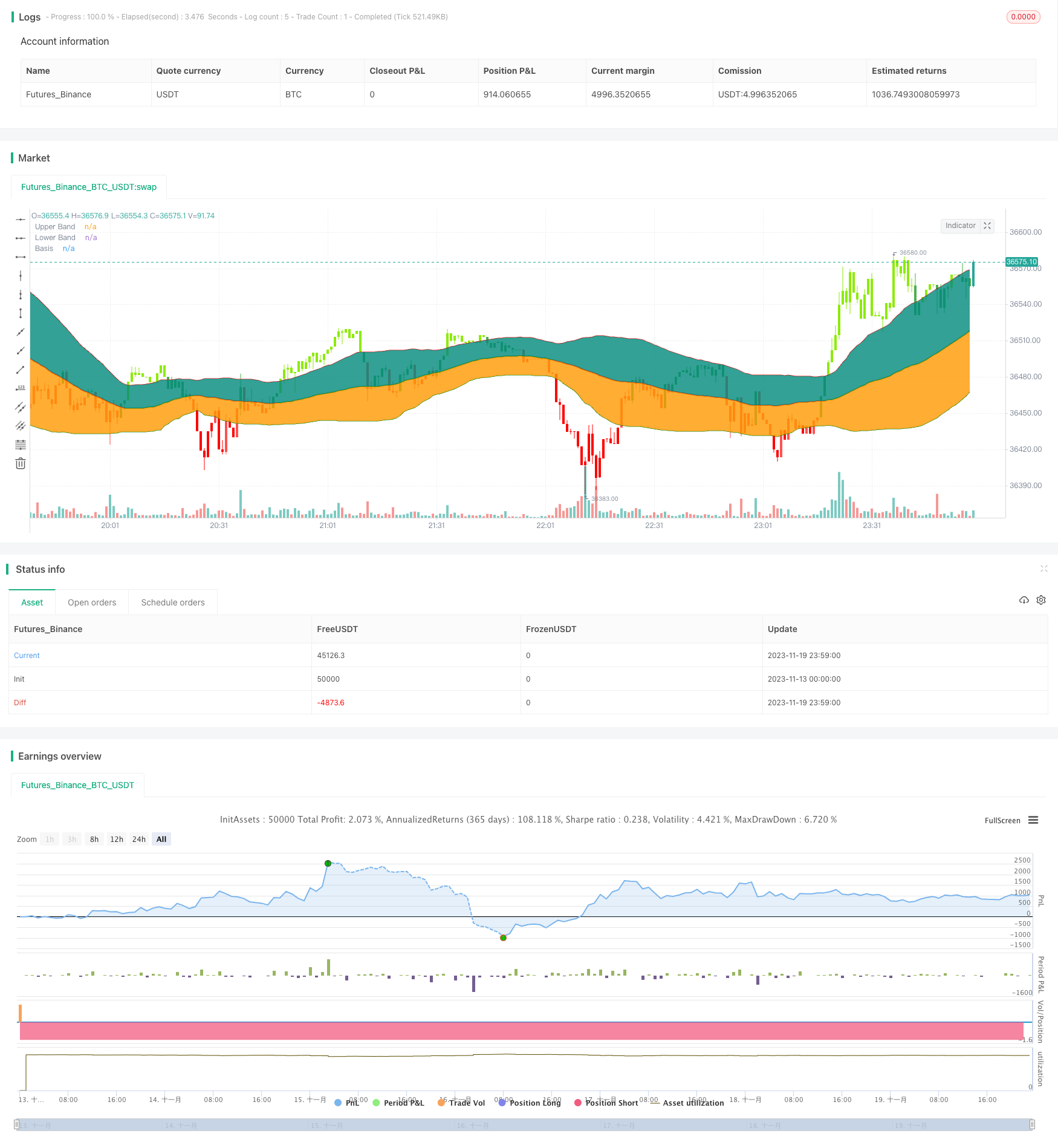Bollinger Bands 標準偏差突破戦略
作者: リン・ハーンチャオチャン,日付: 2023年11月21日 17:14:04タグ:

概要
この戦略は,古典的なボリンジャーバンド指標に基づいています.価格は上部帯以上で閉じるときに長くなって,価格が下部帯以下で閉じるときに短くなります.それはブレイクアウト戦略のトレンドに属します.
戦略の論理
- ベースラインは55日間の単純な移動平均値です
- 上部と下部帯は,基準線よりそれぞれ1標準偏差上,基準線よりそれぞれ1標準偏差下です.
- 長信号は,価格が上位帯以上で閉じるときに生成されます.
- 価格が下帯を下回るとショートシグナルが生成されます.
- 典型的な2つの標準偏差の代わりに1つの標準偏差を使うことでリスクは減少します
利点分析
- 固定値の代わりに標準偏差を使うことでリスクは減少します
- 55日移動平均は中期傾向をよりよく反映できる.
- 密閉した脱出は 偽脱出をフィルターします
- 多期分析によって 傾向の方向を 簡単に判断できます
リスク分析
- 小銭的な利益を得る傾向がある
- 取引手数料の影響を考慮する必要があります
- 突破信号は 偽突破かもしれない
- 滑り損が発生する可能性があります.
ストップ・ロスを設定したり,取引手数料を考慮したり,指標フィルターを追加したりすることでリスクを軽減できます.
オプティマイゼーションの方向性
- 最適な移動平均値を見つけるためにベースラインのパラメータを最適化します.
- 標準偏差の大きさを最適化して最適なパラメータを見つけます
- 判断のために補助音量指標を追加する.
- ストップ・ロストメカニズムを追加します
概要
この戦略の全体的な論理は明確です.標準偏差帯幅を通じてリスクを調整し,近距離ブレイクを使用して誤ったブレイクを回避します.しかし,ストップ損失,フィルターなどを加えることで振動損失を防ぐことがまだ必要です.
/*backtest
start: 2023-11-13 00:00:00
end: 2023-11-20 00:00:00
period: 1m
basePeriod: 1m
exchanges: [{"eid":"Futures_Binance","currency":"BTC_USDT"}]
*/
//@version=4
//┌───── •••• ─────┐//
// TradeChartist //
//└───── •••• ─────┘//
//Bollinger Bands is a classic indicator that uses a simple moving average of 20 periods along with upper and lower bands that are 2 standard deviations away from the basis line.
//These bands help visualize price volatility and trend based on where the price is in relation to the bands.
//This Bollinger Bands filter plots a long signal when price closes above the upper band and plots a short signal when price closes below the lower band.
//It doesn't take into account any other parameters such as Volume/RSI/fundamentals etc, so user must use discretion based on confirmations from another indicator or based on fundamentals.
//This filter's default is 55 SMA and 1 standard deviation, but can be changed based on asset type
//It is definitely worth reading the 22 rules of Bollinger Bands written by John Bollinger.
strategy(shorttitle="BB Breakout Strategy", title="Bollinger Bands Filter", overlay=true,
pyramiding=1, currency=currency.NONE ,
initial_capital = 10000, default_qty_type = strategy.percent_of_equity,
default_qty_value=100, calc_on_every_tick= true, process_orders_on_close=false)
src = input(close, title = "Source")
length = input(55, minval=1, title = "SMA length")// 20 for classis Bollinger Bands SMA line (basis)
mult = input(1., minval=0.236, maxval=2, title="Standard Deviation")//2 for Classic Bollinger Bands //Maxval = 2 as higher the deviation, higher the risk
basis = sma(src, length)
dev = mult * stdev(src,length)
CC = input(true, "Color Bars")
upper = basis + dev
lower = basis - dev
//Conditions for Long and Short - Extra filter condition can be used such as RSI or CCI etc.
short = src<lower// and rsi(close,14)<40
long = src>upper// and rsi(close,14)>60
L1 = barssince(long)
S1 = barssince(short)
longSignal = L1<S1 and not (L1<S1)[1]
shortSignal = S1<L1 and not (S1<L1)[1]
//Plots and Fills
////Long/Short shapes with text
// plotshape(S1<L1 and not (S1<L1)[1]?close:na, text = "sᴇʟʟ", textcolor=#ff0100, color=#ff0100, style=shape.triangledown, size=size.small, location=location.abovebar, transp=0, title = "SELL", editable = true)
// plotshape(L1<S1 and not (L1<S1)[1]?close:na, text = "ʙᴜʏ", textcolor = #008000, color=#008000, style=shape.triangleup, size=size.small, location=location.belowbar, transp=0, title = "BUY", editable = true)
// plotshape(shortSignal?close:na, color=#ff0100, style=shape.triangledown, size=size.small, location=location.abovebar, transp=0, title = "Short Signal", editable = true)
// plotshape(longSignal?close:na, color=#008000, style=shape.triangleup, size=size.small, location=location.belowbar, transp=0, title = "Long Signal", editable = true)
p1 = plot(upper, color=#ff0000, display=display.all, transp=75, title = "Upper Band")
p2 = plot(lower, color=#008000, display=display.all, transp=75, title = "Lower Band")
p = plot(basis, color=L1<S1?#008000:S1<L1?#ff0000:na, linewidth=2, editable=false, title="Basis")
fill(p,p1, color=color.teal, transp=85, title = "Top Fill") //fill for basis-upper
fill(p,p2, color=color.orange, transp=85, title = "Bottom Fill")//fill for basis-lower
//Barcolor
bcol = src>upper?color.new(#8ceb07,0):
src<lower?color.new(#ff0000,0):
src>basis?color.green:
src<basis?color.red:na
barcolor(CC?bcol:na, editable=false, title = "Color Bars")
// //Alerts ---- // Use 'Once per bar close'
// alertcondition(condition=longSignal, title="Long - BB Filter", message='BB Filter Long @ {{close}}') // Use 'Once per bar close'
// alertcondition(condition=shortSignal, title="Short - BB Filter", message='BB Filter Short @ {{close}}') // Use 'Once per bar close'
Notestart1 = input(true, "╔═══ Time Range to BackTest ═══╗")
// === INPUT BACKTEST RANGE ===
FromMonth = input(defval=1, title="From Month", minval=1, maxval=12)
FromDay = input(defval=1, title="From Day", minval=1, maxval=31)
FromYear = input(defval=2018, title="From Year", minval=2015)
ToMonth = input(defval=1, title="To Month", minval=1, maxval=12)
ToDay = input(defval=1, title="To Day", minval=1, maxval=31)
ToYear = input(defval=9999, title="To Year", minval=2010)
// === FUNCTION EXAMPLE ===
start = timestamp(FromYear, FromMonth, FromDay, 00, 00) // backtest start window
finish = timestamp(ToYear, ToMonth, ToDay, 23, 59) // backtest finish window
window() => // create function "within window of time"
time >= start and time <= finish ? true : false
if(window())
strategy.entry("Long", long=true, when = longSignal)
// strategy.close("Long", when = (short and S3==0), comment = "Close Long")
if(window())
strategy.entry("Short", long=false, when = shortSignal)
// strategy.close("Short", when = (long and L3==0), comment = "Close Short")
もっと
- 123 逆転 移動平均 収束 差異 組み合わせ戦略
- ハイキン・アシ 高低チャネル ダイナミック・ムービング・平均取引戦略
- 定量的な金十字戦略
- イチモク・クラウドとMACDモメンタム・ライディング戦略
- 複数の移動平均のブレイクアウト戦略
- ストカスティックOTT取引戦略
- 2つの移動平均逆転戦略
- 量子取引のダブルクリック逆転戦略
- ファイボナッチチャネルベースのキャンドルスティック逆転取引戦略
- 動的移動平均トレンドクロスオーバー戦略
- VSTOCHASTIC RSI EMA CROSSOVER VMACD ウェーブファインダー戦略と組み合わせた
- 多時間枠ダイナミックバックテスト戦略
- 逆転 短期間のブレイクアウト取引戦略
- 2つの移動平均のクロスオーバー矢印戦略
- モメント・オシレーション・トレーディング・戦略
- RSI+CCI+ボリンジャーバンド DCA戦略
- フィボナッチリトレースメント量的な取引戦略
- 2つの指標による振動戦略
- 2重移動平均価格突破戦略
- ダイナミックストップ・ロスト・トレイル戦略